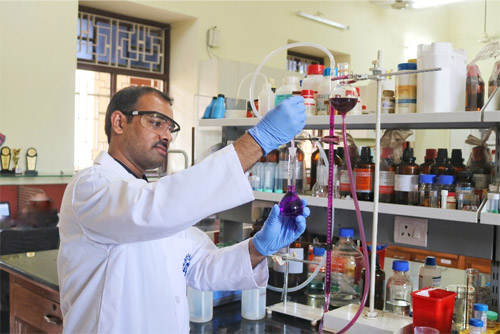 Dr. Amit Ashok Vernekar, Scientist at Inorganic and Physical Chemistry Laboratory CSIR-Central Leather Research Institute (CLRI) Chennai, is a recipient of the INSPIRE Faculty Award instituted by the Department of Science & Technology, Government of India. Along with his research group, Dr. Vernekar engineers nanozymes or nanomaterials-based enzyme mimics for therapeutics, biomedical, and environmental applications.
Dr. Amit Ashok Vernekar, Scientist at Inorganic and Physical Chemistry Laboratory CSIR-Central Leather Research Institute (CLRI) Chennai, is a recipient of the INSPIRE Faculty Award instituted by the Department of Science & Technology, Government of India. Along with his research group, Dr. Vernekar engineers nanozymes or nanomaterials-based enzyme mimics for therapeutics, biomedical, and environmental applications.
The nanozymes engineered help improve their efficacy and selectivity for high-throughput applications as therapeutics. He is also looking at designing nanozymes for sustainable hydrogen production.
‘Nanomaterials-based enzyme mimics’ or nanozymes are the new facet of bioinorganic and biomimetic chemistry dealing with chemical systems that can simulate biological phenomena that offer several advantages over enzymes in terms of isolation, purification, and application.
However, several challenges, such as catalytic efficacy, biocompatibility, selectivity, and so on, are encountered in the case of nanozymes.In his laboratory, Dr. Vernekar, along with his team, has been engineering the structure of nanozymes to improve their activities, so that their catalytic efficiencies can be escalated to reach the values reported for enzymes.
The structural engineering of nanomaterials and improving their redox potentials by tuning the metal composition in the crystal lattices significantly affect the catalytic efficiency of materials. Recently his research group found that replacing parent transition metal ions in the crystal lattice with different metal ions has a tremendous effect on the ions present at the surface or the ions which are exposed to the reaction environment. Such property has been utilized to potentially activate oxygen in a way similar to that of some metalloenzymes function in the biological system.
Peroxidase and oxidase nanozymes have been reported to be active at acidic pH. However, by structurally engineering nanozymes, Dr Vernekar’s group has not only achieved the record-breaking catalytic efficiency at acidic pH but also extended the efficiency window towards neutral pH-- a significant achievement in the area of nanozymes’ chemistry.
“As such, engineered nanozymes from my laboratory will have wide applicability in biochemical reactions, therapeutics, and catalysis, as they can function efficiently at neutral pH. We are currently looking further to studying the engineered nanozymes for biomedical and environmental applications,” said Dr. Vernekar.
Dr. Vernekar will use the DST Inspire research grant for investigation on improving the chemistry of nanozymes, especially to come up with the next generation nanozymes. These nanozymes are expected to have wide applicability as therapeutics for treating diseases like cancer, neurodegeneration, inflammation, and microbial infection. The engineered nanozymes can also be of great help in the field of sustainable chemistry and energy, supporting many industrially important reactions in a greener way.
For more details please contact: Dr. Amit Ashok Vernekar, Email: amitvernekarnano[at]gmail[dot]com






























